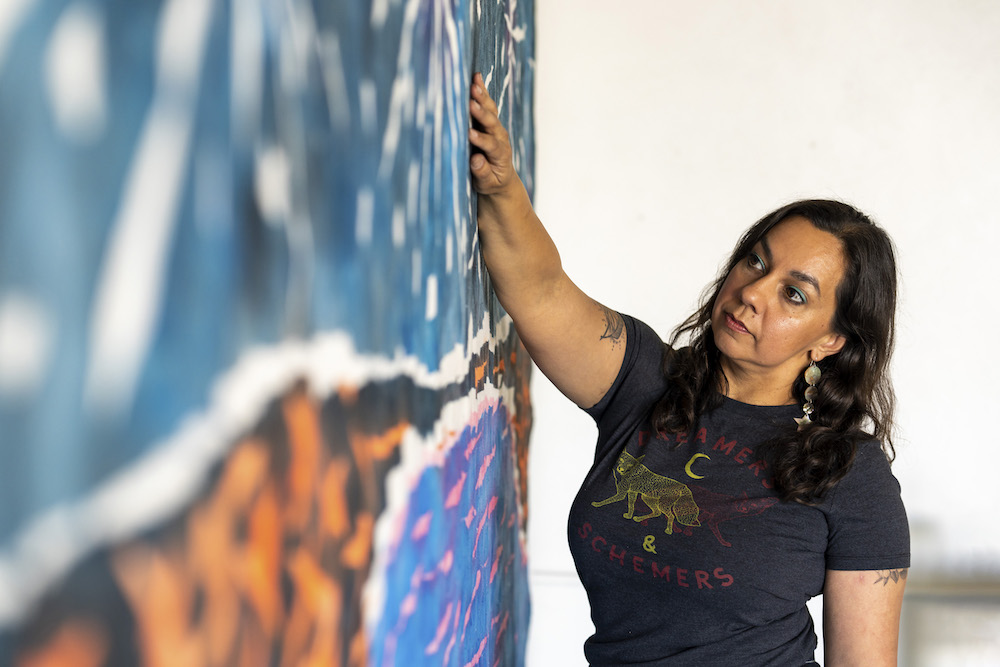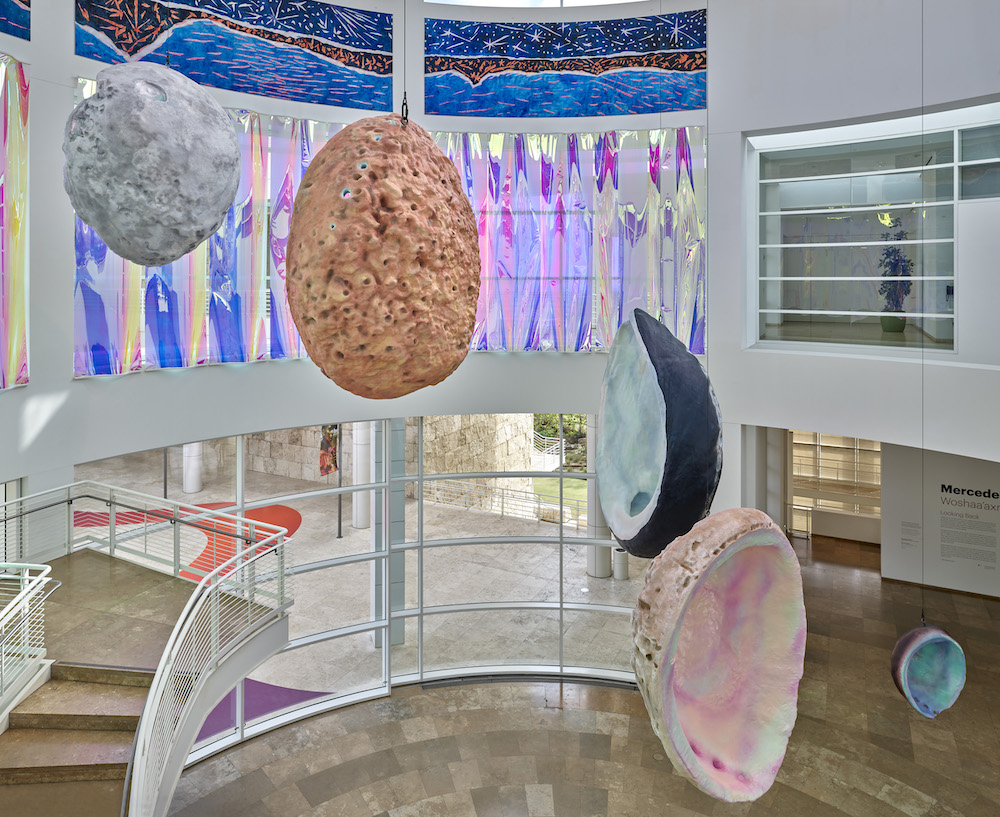At the Getty Center, Los Angeles’ world-famous “treasure box on the hill” bearing the name of oil tycoon J. Paul Getty, a monumental shift is underway. I chatted with Tongva artist Mercedes Dorame, whose art is at the center of it all.
“Mercedes Dorame: Woshaa’axre Yang’aro (Looking Back),” the inaugural installation for the Getty’s Rotunda Commission series, marks the museum’s first solo presentation by an Indigenous Californian from the Los Angeles basin and the southern Channel Islands, the ancestral land on which the Getty Center was erected in 1997.
Growing up in Tovaangar (Los Angeles), Dorame heard many times while up at the Getty, “On a clear day, you can see Catalina Island!” The invitation to create an installation inspired by the site got her thinking about the ways humans hierarchically place themselves above other beings and plants, and how she could encourage a reversal of that assumed power structure to privilege the information that other beings can teach us.
In “Looking Back,” high above visitors’ heads as they move through the threshold of the entrance hall, five sculptures of abalone shells as tall as 12 feet rotate slowly—like wise gentle giants swaying underwater in a slowly moving current. The ear-shaped shells’ iconic mother-of-pearl innermost layers catch sunlight streaming in from the rotunda’s tall, second-story windows, as filtered through bright pink iridescent material, adding dappled light to the underwater effect. A four-panel panorama view of the Tongva coastline looking back from Pimugna (Catalina Island)—painted from memory as it appears in Dorame’s mind’s eye after many research trips—encircles the top of the rotunda. A tranquil, peaceful energy fills the space as it is transformed by the monumental presence of these spiritual guides.

Mercedes Dorame.
Dorame’s successful reversal of our external relationship to scale and power begs us to reconsider our loyalties to the social structures built by humans in an attempt to rule the world. When we look out from the Getty to Catalina Island, where abalone still live and thrive naturally, perhaps we should consider the returned gaze of the island, looking back at the museum, and the sacred knowledge that abalone have to teach us.
Perhaps only art can sweet-talk us into subverting our biases in such a way.
American museums, especially those like the Getty, the world’s wealthiest art institution, haven’t historically been representative and inclusive of the global majority when it comes to what art is collected and which audiences are cultivated. A culture of ignorance inevitably builds around communities least represented in public presentations and interpretations of beauty and history. This is understandably distressing to those of us from those communities.
For example, Dorame noted, “Abalone and white sage have lost their citation.” Consider their increasingly ubiquitous presence in spiritual shops, their mere presence glaringly out of accordance with the Indigenous tradition of gifting such sacred materials. A surge in popular demand for materials used in the pan-spiritual practice of smudging, or cleansing with the smoke of sacred herbs, is in part to blame for their over-harvesting. “That’s so devastating to us as people,” Dorame explained, because “there’s been so much erasure around who we are, and what our culture is—while, simultaneously, things [like sage and abalone] have been appropriated into mass culture.”

Installation views: “Woshaa’axre Yang’aro (Looking Back).” Courtesy of the Getty Museum.
While the Getty has much more ground to cover if they aim to repair audiences’ underexposure to and misunderstanding of the communities that they historically ignored, “Looking Back” is a step in the right direction.
“I know a lot of people of color, in general, have a hard time feeling comfortable in big museum institutional spaces,” said Dorame. “How do you get people to come to a museum? Well,” she laughed, “you show people of color. From my experience, the intention was there to acknowledge that there hasn’t been [Tongva] representation in this institution prior to this.”
The Getty smartly invited Meztli Projects, artist and organizer Joel Garcia’s Indigenous-based arts and culture collaborative, to curate the opening celebration. Throngs of visitors in their most festive attire marked this seminal occasion by enjoying food prepared from the Chia Café Collective cookbook, flower arrangements featuring native plants and blessings offered by Dorame and her father—a powerful demonstration of how successful a global museum’s local community engagement can be when it leads with inclusion.


